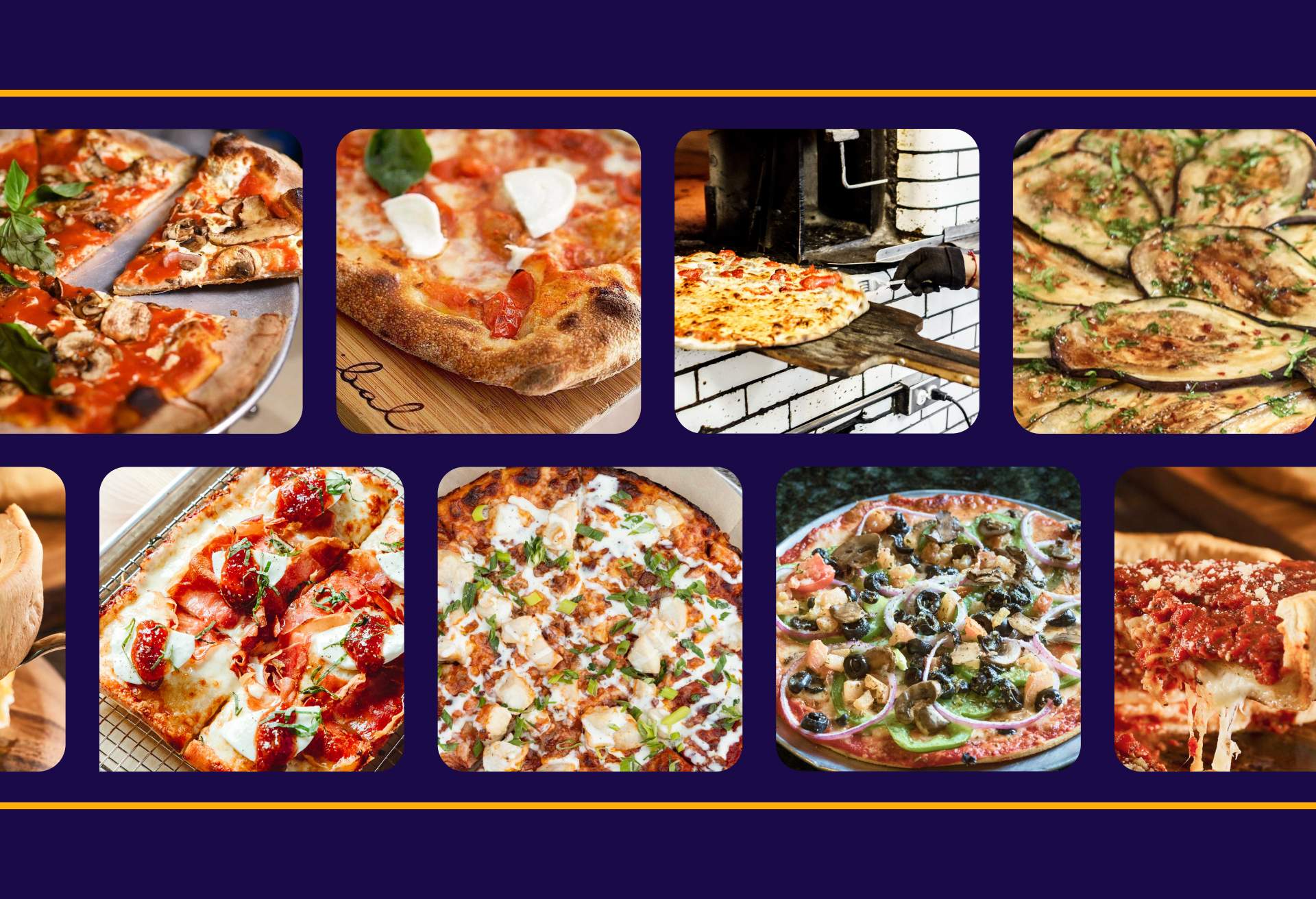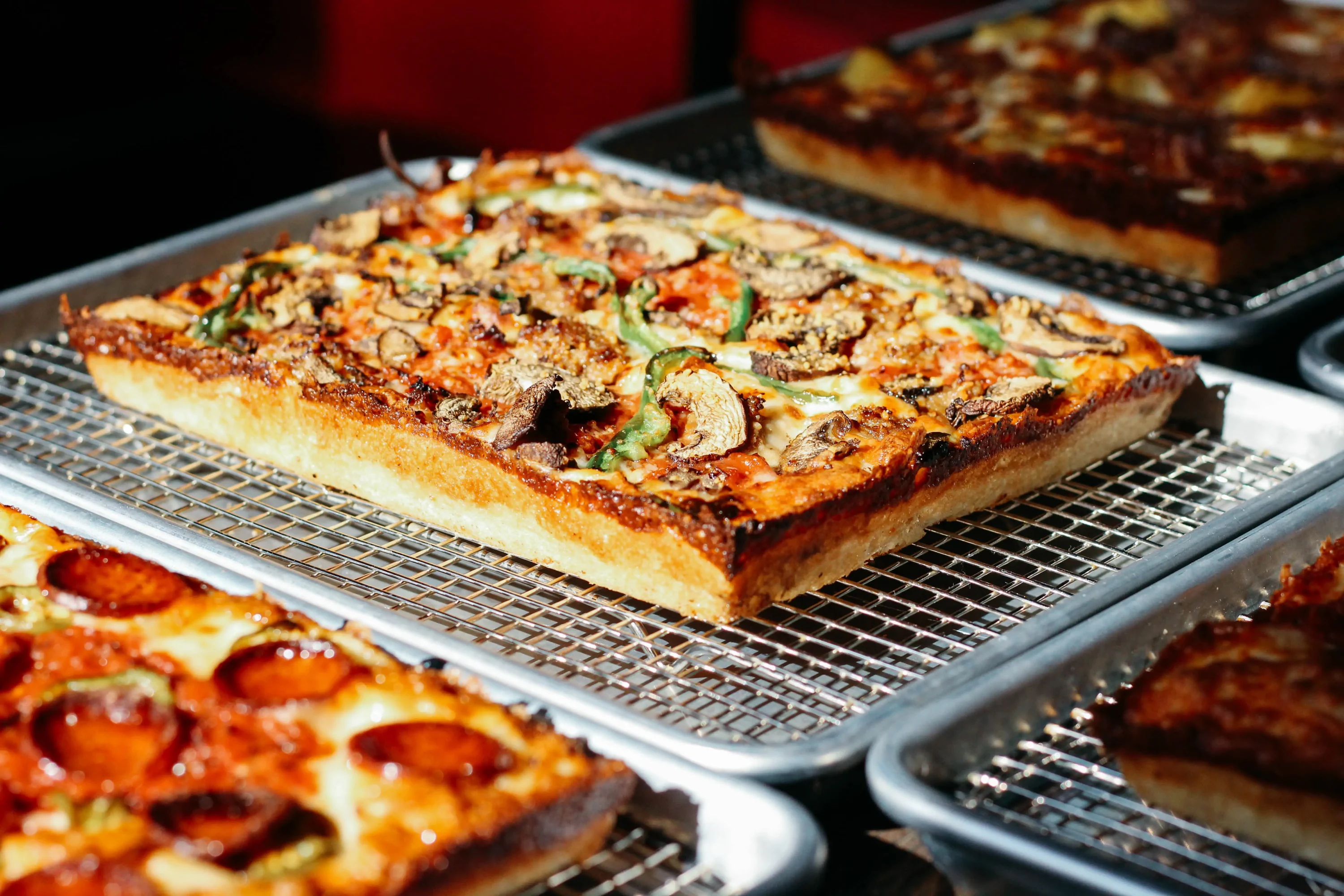Easy to eat, inexpensive, and quick to cook—along with being simply delicious—pizza is one of the most universally revered meals any way you slice it. What began in Naples and gained massive appeal with the waves of Italian immigrants coming to the United States in the 20th century has risen to the top of the food chain like dough set out overnight.
Countless iterations on the classic Neapolitan version—from Detroit’s thick rectangular slices to Chicago’s deep dish pies—use regional cheeses in lieu of mozzarella, employ crusts of all textures, and come in shapes as varied as toppings preferences. It can be confusing to tell the difference, so this handy guide lays out what makes New York style unique from New Haven.

One of the hallmarks of Neapolitan pizza is its crust, which is truly the best of both worlds—crispy, yet soft at the same time. The canvas that’s both pillowy and charred is baked fast in a wood-fired oven at temperatures around 800 to 1,000 degrees Fahrenheit, and toppings are typically kept to a minimum. Fresh mozzarella, freshly torn basil, San Marzano tomatoes, and garlic are the most common used by pizzaiolos, who have their own association to certify their culinary art form. The Association Vera Pizza Napoletana (VPN in the Americas) is a protected designation accrediting those who take special training.
Where to try: Ribalta in New York City, Pizzeria Mozza in Los Angeles, and Basil & Barley in Colorado Springs, Colorado

One of the most distinctive features of a Detroit-style pizza is its rectangular shape, although by no means is it the only characteristic that’s worth noting. Pies are traditionally baked in steel trays, a throwback to the plates that were used by Detroit automotive giants to hold small parts on assembly lines. The Midwest flavor carries throughout, with brick cheese traditionally sourced from Wisconsin that extends all the way to the edges for a style that features little to no crust. Pepperoni is a favorite topping, and the smaller cups used on Detroit-style curl up for an extra-crunchy bite.
Where to try: Night Shift Brewing Lovejoy Wharf in Boston, Emmy Squared in Nashville, and Cloverleaf Bar & Restaurant in Detroit

Few culinary delights are as synonymous with New York as its pizza—and for good reason. The thin crust is tossed by hand and crispy enough to hold toppings but pliable enough to be folded in half for a casual or on-the-go experience. Less is more on a New York pie, and sauce is minimally but artfully imbued with herbs and olive oil. Dry, grated mozzarella (as opposed to the more moist varieties on a Neapolitan pie) brown just so in coal-fired ovens.
Where to try: Angelo’s Pizza in New York City, Joe’s New York Pizza in Las Vegas, and John’s of Bleecker Street in New York City

It’s no surprise that New Haven pies are similar to New York-style given their geographic proximity—but there are a few unforgettable singularities. Connecticut pizza tends to be thinner, with an oblong crust. Cooked with coal at an average of 50 degrees higher Fahrenheit, New Haven-style crust also features a touch more char. Mozzarella cheese is considered a topping, not an essential—so if you don’t explicitly state that you’d like what Connecticut locals call “mootz,” your pizza may arrive more austere than planned.
Where to try: Frank Pepe’s in Watertown, Massachusetts; Sally’s Apizza in New Haven, Connecticut, and Nick’s New Haven Style Pizzeria & Bar in Boca Raton, Florida

Don’t expect a pizzaiolo to roll out a traditional round cutter at Roman-style shops; instead, it’s tradition for diners to gesture with their hands the approximate size square they want from large rectangular trays, which are then cut with pizza scissors. Unlike Neapolitan pizza dough, high-protein wheat flour has a touch of olive oil for a richer crust that becomes extra crispy, while also serving as the platform that’s sturdy enough for an abundance of meats, cheese, and vegetables.
Where to try: Alice Pizza in Philadelphia, Ducali Pizzeria in Boston, and Triple Beam Pizza in Los Angeles

The biggest difference between flatbread and other pizzas is the dough. Flatbreads don’t use yeast, which cuts down on the time to rise and makes them thinner—and friendlier for those on low-carb diets. Often oblong, this style is as eye-catching as it is crunchy. Toppings tend to be lighter in weight, so as to not overload the thin “palette.”
Where to try: Rail Trail Flatbread Co. in Hudson, Massachusetts, Basta Pasta in Eldersburg, Maryland, and Slim & Husky’s in Atlanta

Don’t expect cloth napkins when bar pizza is served—the only frills on this pie are the crispy “laced” edges where a smattering of cheese extends to the perimeter. The style is particular to the South Shore of Massachusetts (read, south of Boston), cooked in steel pans made locally in the working-class borough of Quincy. While the 10-inch diameter may sound daunting for just one person, the thin, cracker-like crust means most diners order a whole one just for themselves.
Where to try: Lodge Bar and Grill in Randolph, Massachusetts, Bardo’s Bar Pizza at Castle Island Brewing in South Boston, and Cape Cod Pizza Cafe in Brockton, Massachusetts

The original deep dish pizza has a heft made for sharing. Chunky marinara tomato sauce and thick mozzarella laced with grated parmesan are all nestled atop a wheat flour dough mix that’s spread out more like a dessert pie. The difference here? The iron skillet or round, steel pan is oiled to allow for easy removal—which also creates an extra-indulgent fried-like effect.
Where to try: Pizzeria Ora in Chicago, La Barra in Riverside, Illinois, and Pequod’s Pizza in Morton Grove, Illinois

Expect a “party” with this style of slice, where 3- or 4-inch squares are typically called “party” or “tavern” cuts. Each is super-thin and cracker-like, covered in Provel (a combination of provolone, Swiss, and white cheddar cheeses), as opposed to the mozzarella sprinkled on most other styles of pie. That cheese and oregano-heavy sauce extends all the way to the pie’s edges, and you’ll find nary a traditional crust.
Where to try: Guido’s in St. Louis, Faraci Pizza in Ellisville, Missouri, and Speedy Romeo in New York City




